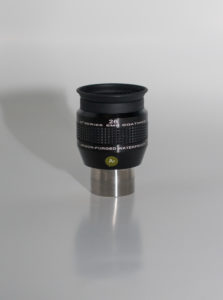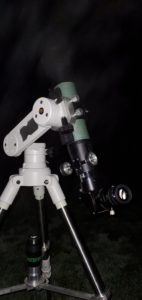Explore Scientific 24mm 68° vs 26mm 62° Eyepiece Review
By: Vlad Fedosov
Intro:
The Explore Scientific(ES) 62° line of eyepieces is a relative newcomer compared to the 68° that has been available for quite some time. I have owned the ES 40mm and 24mm 68° eyepieces for years and when I picked up the newer 26mm 62° I could not resist the chance to see how the 24mm would compare! Both the 24mm and 26mm are 1.25” eyepieces that essential maximize the widest possible field of view(FOV) out of the 1.25” eyepiece format. The 24mm 68° MSPR’s for: $189.99, weighs in at 11.6oz, and has an eye relief of 18.4mm while the 26mm 62* MSPR’s for: $129.99, weighs in at 8.2oz, and has an eye relief of 19.3mm. Both of the eyepieces are waterproof. Let’s get down to business and find out which one of these guys is the eyepiece to go with!

Testing:
I did the test of these eyepieces from my Mag 5.5 semi-dark sky backyard in the Portland, OR area. The seeing and transparency on this particular night were about average. The scope that I had out was my TeleVue TV-85. With this scope the 26mm produces 23.1x with a 2.68° FOV. The 24mm produces 25x with a 2.72° FOV. The main targets that I used for the comparison were open star clusters including m45 and m34.
Since I was quite used to the 24mm having owned it for years I already knew what to expect performance-wise with it so I was excited to put the new 26mm in the focuser and give it a try! Before I took a look through the eyepiece I had figured that the eyepieces would be very close in performance and that the slight difference in FOV between 62° and 68° would not be too noticeable. The first impression of looking through the 26mm is that the FOV was actually significantly narrower:( I would not figure that only 6° would make such a difference but it does! Let me explain. Besides the 68° eyepieces I also use 82° and 100° ES lines of eyepieces. Even though I have the wider FOV eyepiece I always enjoy using the 68° as they are lighter weight wise as well as providing a wide-enough(just barely) FOV that is easy to take in all at once. Basically, the 68° eyepieces still make me feel like I’m observing with a wide field eyepiece. With the 62° I really start to feel like I’m now in the narrow Plossl class of eyepiece FOV…
 With the initial impressions out of the way, I started to compare the view that these guys provided on m45 by swapping one eyepiece out for the other. Overall the object was a tad better framed with the 24mm because of the slightly larger true FOV but it was not a huge difference. Even though the 24mm does provide a bit more magnification I did not find that this slight difference made a large impact on how dark the background sky looked. The overall contrast of the eyepieces was good and not substantially different.
With the initial impressions out of the way, I started to compare the view that these guys provided on m45 by swapping one eyepiece out for the other. Overall the object was a tad better framed with the 24mm because of the slightly larger true FOV but it was not a huge difference. Even though the 24mm does provide a bit more magnification I did not find that this slight difference made a large impact on how dark the background sky looked. The overall contrast of the eyepieces was good and not substantially different.
While swapping between the eyepieces I did notice that for one reason or another it was not as easy to get a crisp focus with the 26mm. Once I achieved focus the image did appear about as sharp from one eyepiece to the other in the center of the FOV. I think this has to do with the fact that the 26mm requires your eye to be more on-axis for stars to look like a point of light. The 24mm is certainly more forgiving in this regard. Speaking about the eye placement with the eyepieces I did really enjoy the eye relief of the 26mm. It’s long enough that I can have the eyecup up and still see the entire FOV very comfortably. With the 24mm I really need the eyecup down to see the entire FOV all at once. Just in general that extra bit of eye relief that the 26mm offers is very nice!
I next proceeded to test the edge correction of the eyepiece. I have tested the 24mm many times in this regard and was familiar with its fairly good edge correction(not perfect though. See my 24mm Panoptic vs 24mm ES 68° review). The 24mm has stars that are sharp out to about 80% of the FOV before it begins to show coma(if your not familiar with this it’s where stars do not look like points of light but more like little comets). Once I examined the view with the 26mm I was shocked to see that the eyepiece exhibited coma at around 60% of the FOV! That was certainly not a welcome sight considering that the eyepiece was also narrower than the 24mm to begin with. Overall the difference is not huge but I do find this to be a fairly decent drawback especially if you’re observing open star clusters with a faster scope(f/6 and quicker).
Conclusion:
In conclusion which eyepiece should you consider? Is the 24mm worth the extra $40 over the 26mm? Well, truth be told for me it’s an easy choice. The 24mm truly maximizes the widest possible FOV out of the 1.25” form factor, it is substantially better corrected, and really not that much more expensive. So yes I would really recommend that you spend the few extra bucks and get the 24mm. The only reason that I would recommend the 26mm is if you really need that extra bit of eye relief.
Support AVT-ASTRO
If you found this review helpful and are considering purchasing the product that was discusses please concider purchasing this item on Amazon using the link here. I get a small commission from Amazon and it really helps to pay for running this site!
